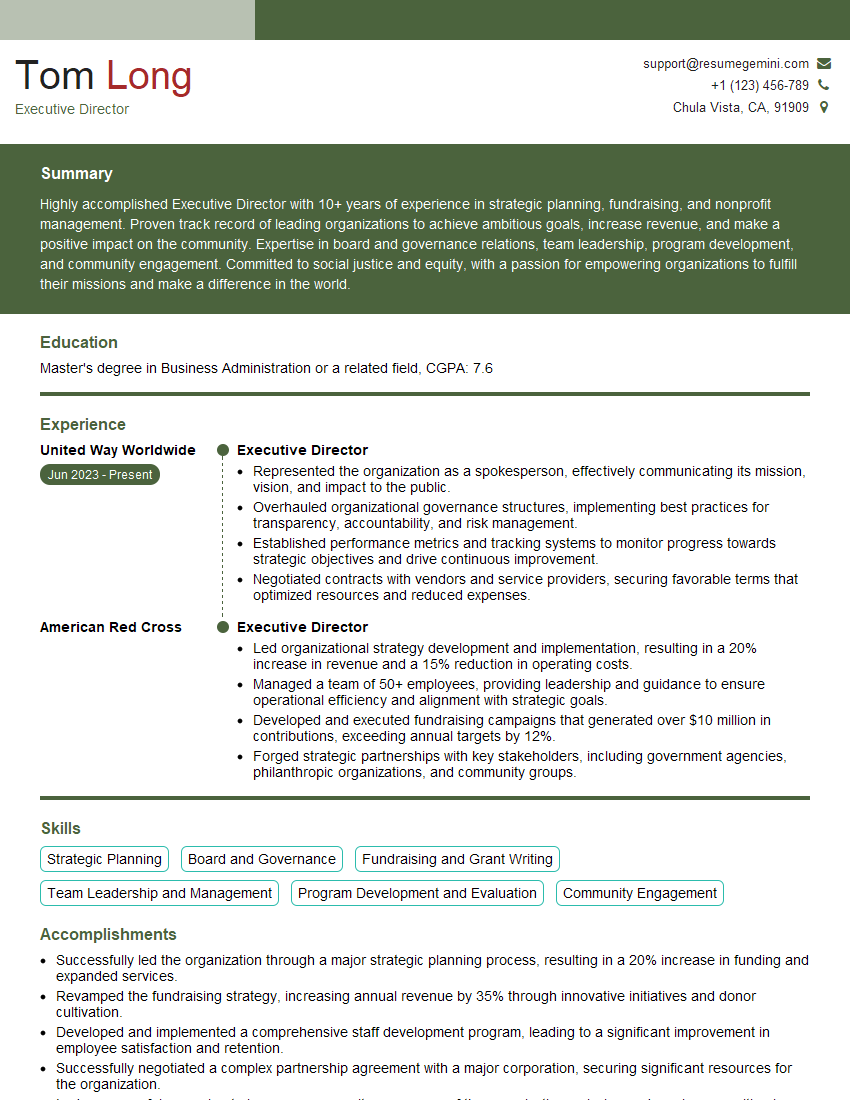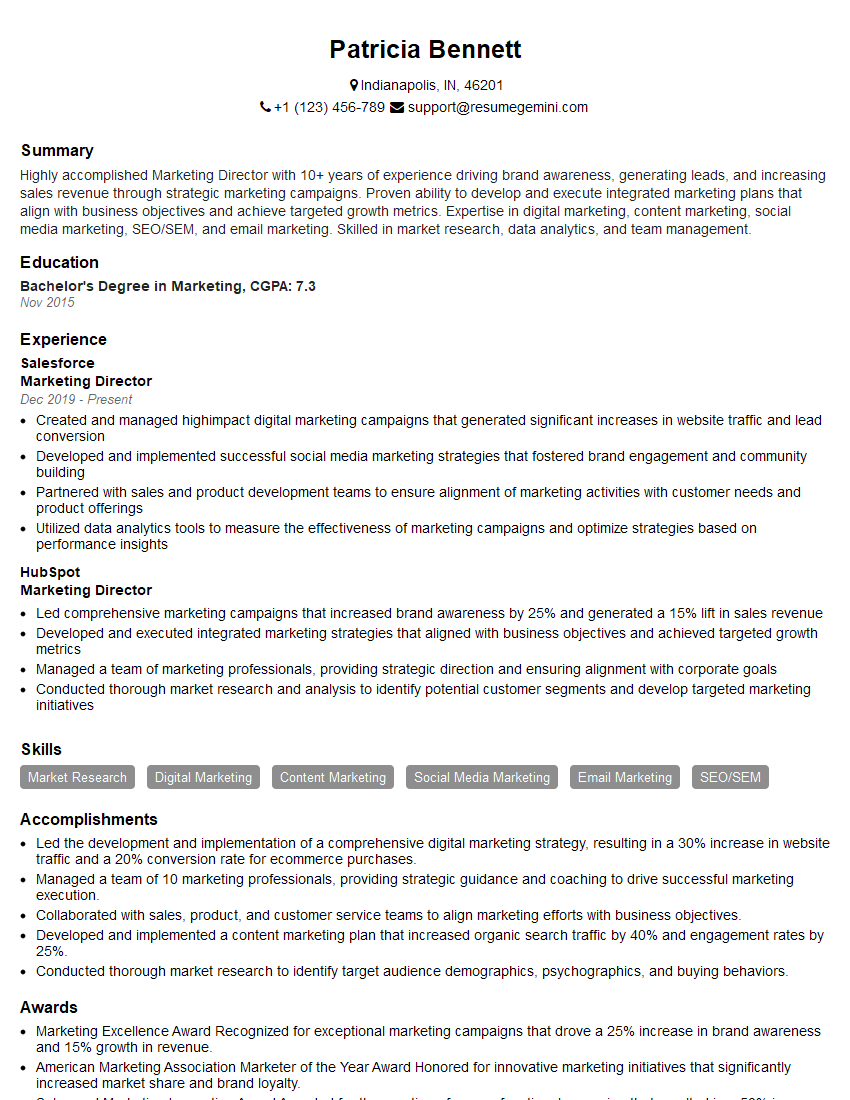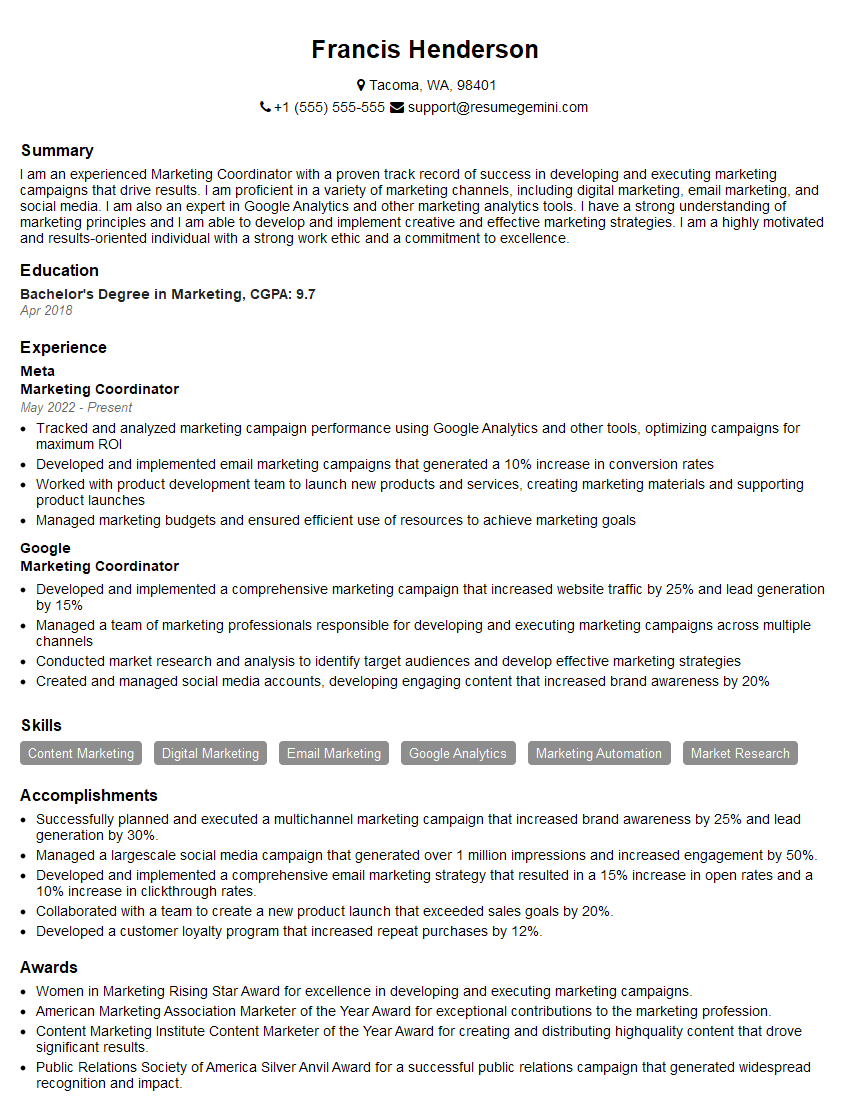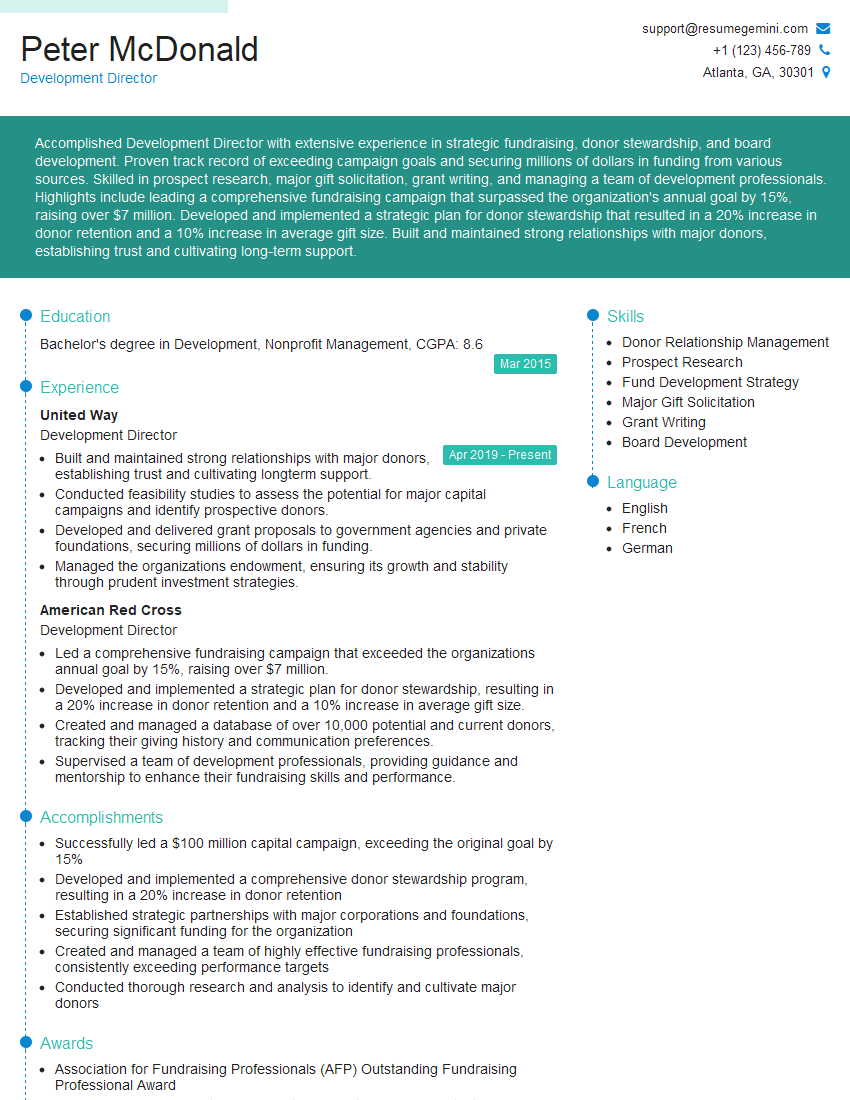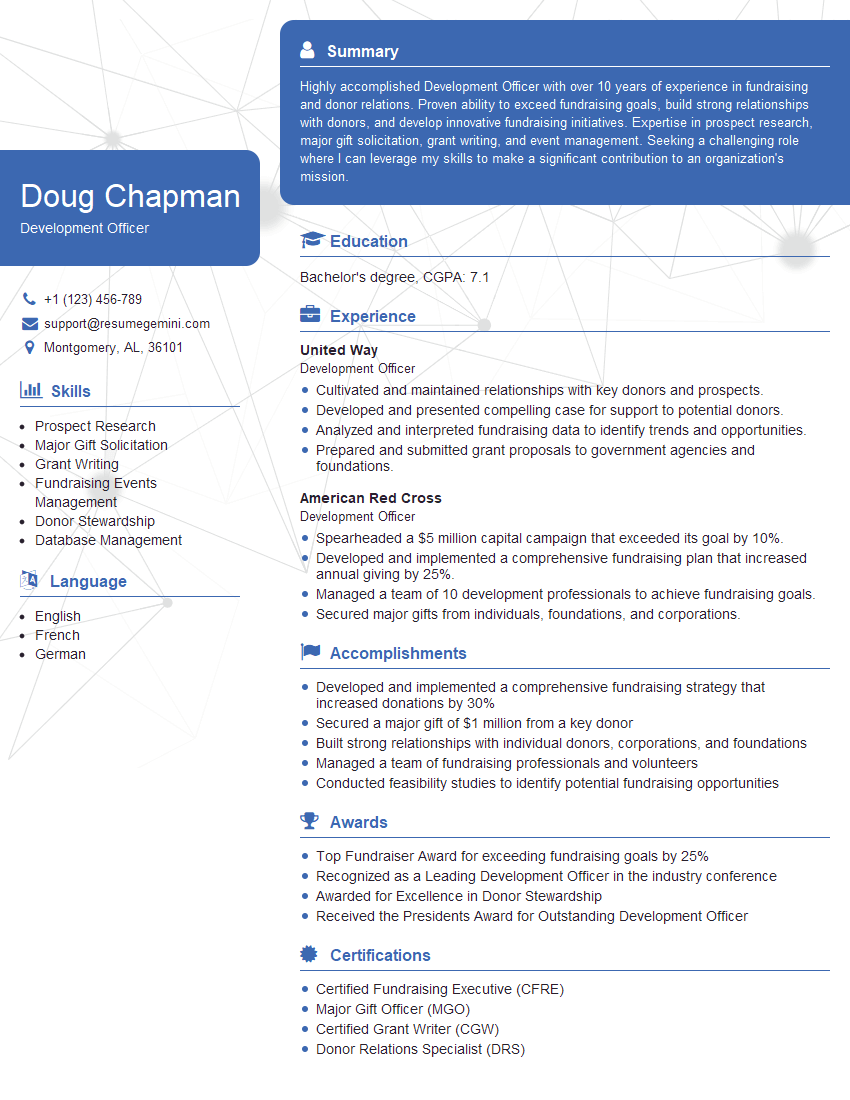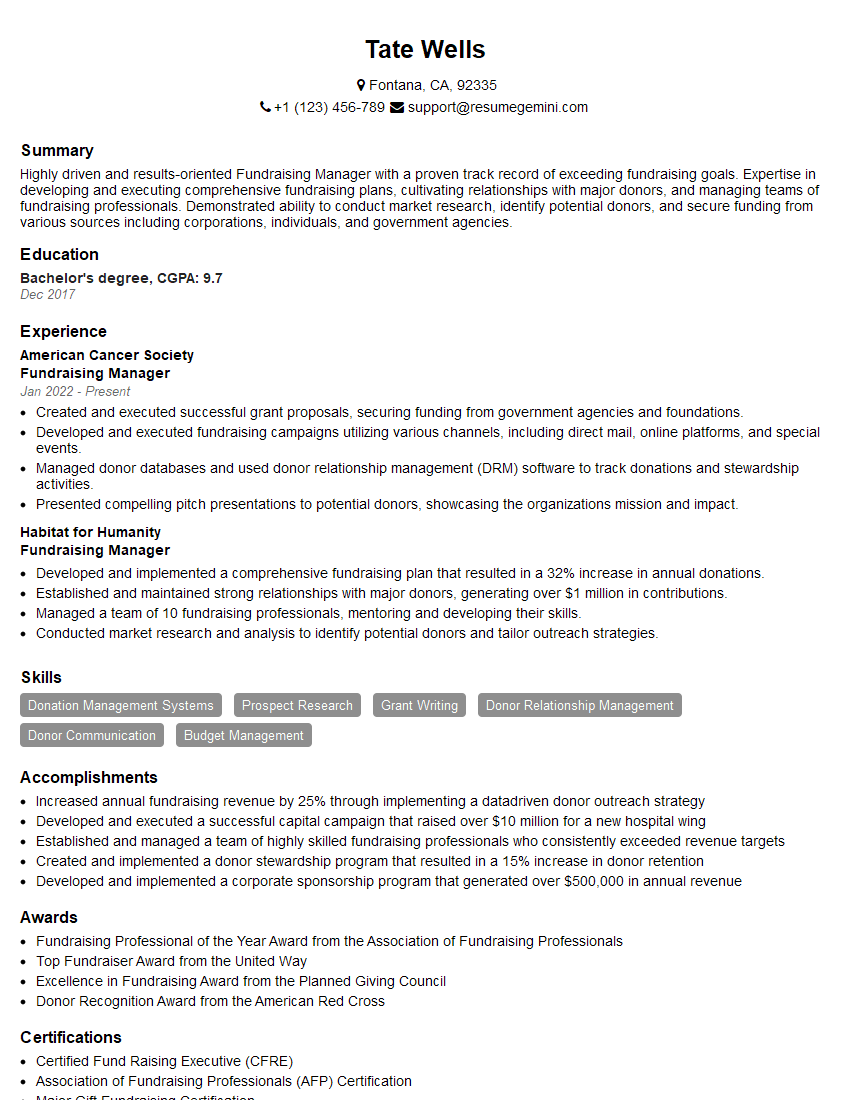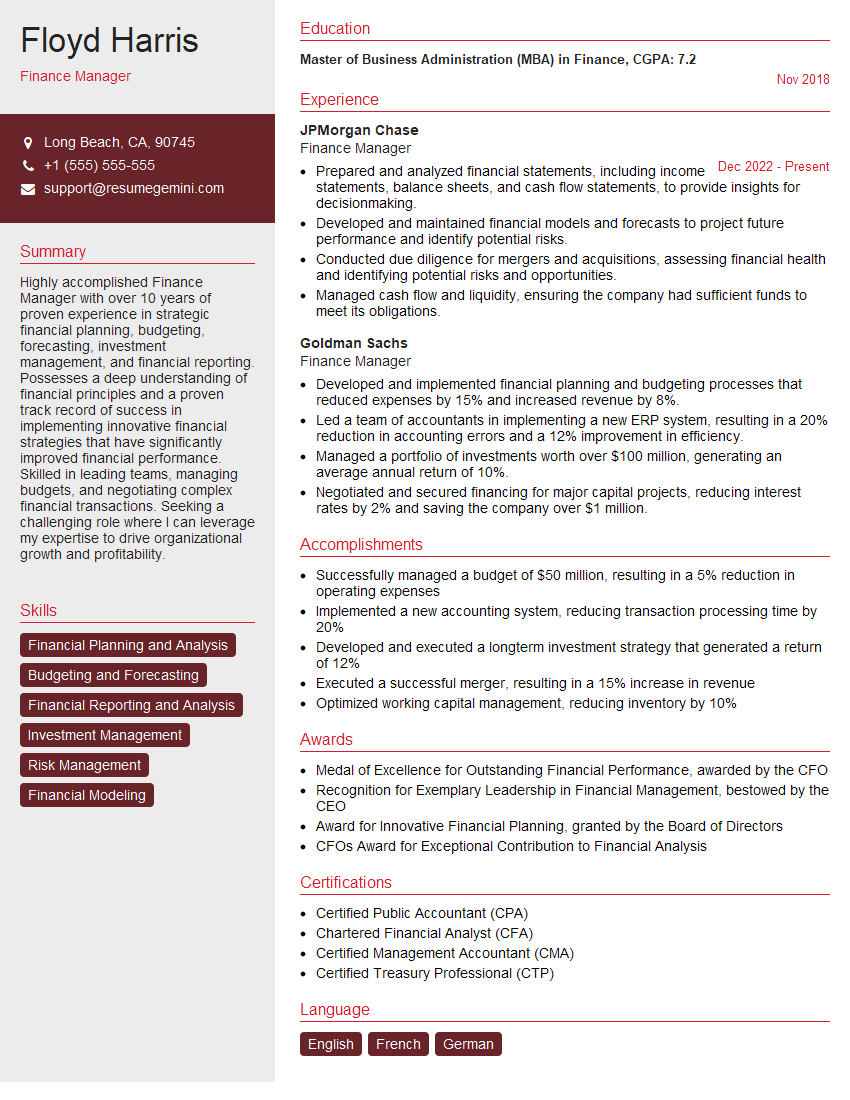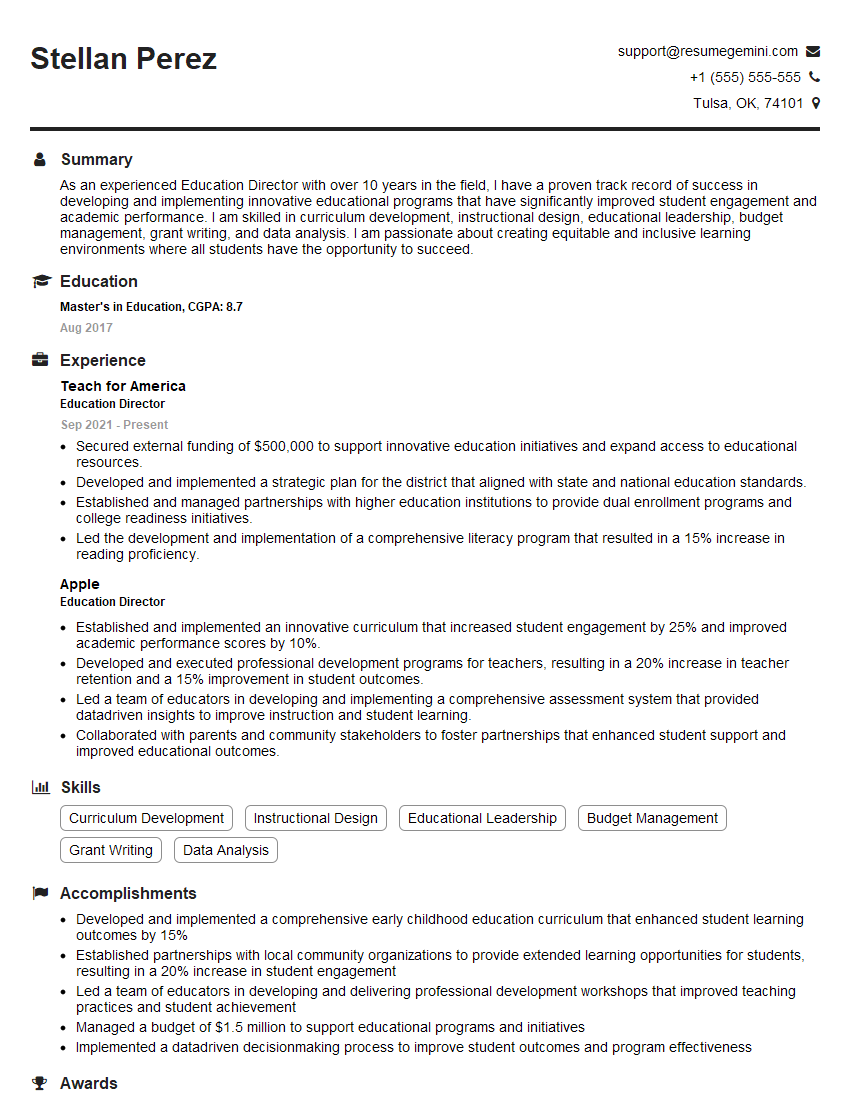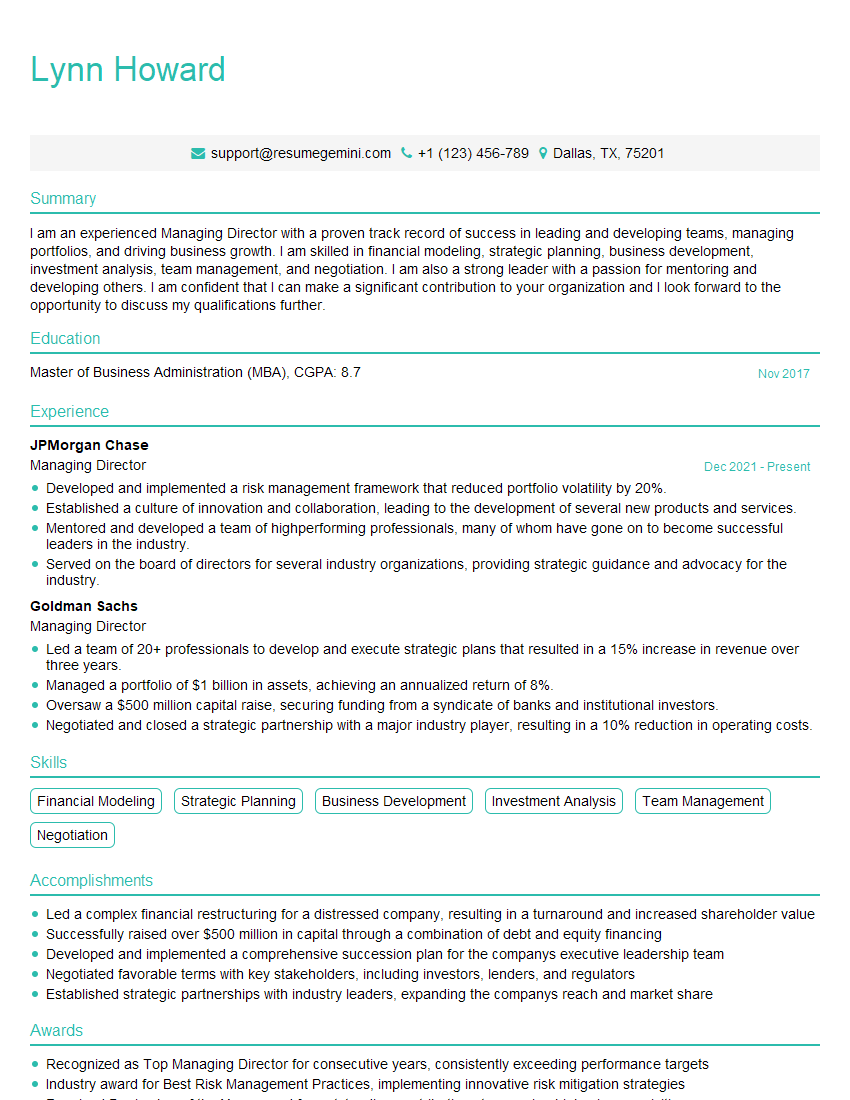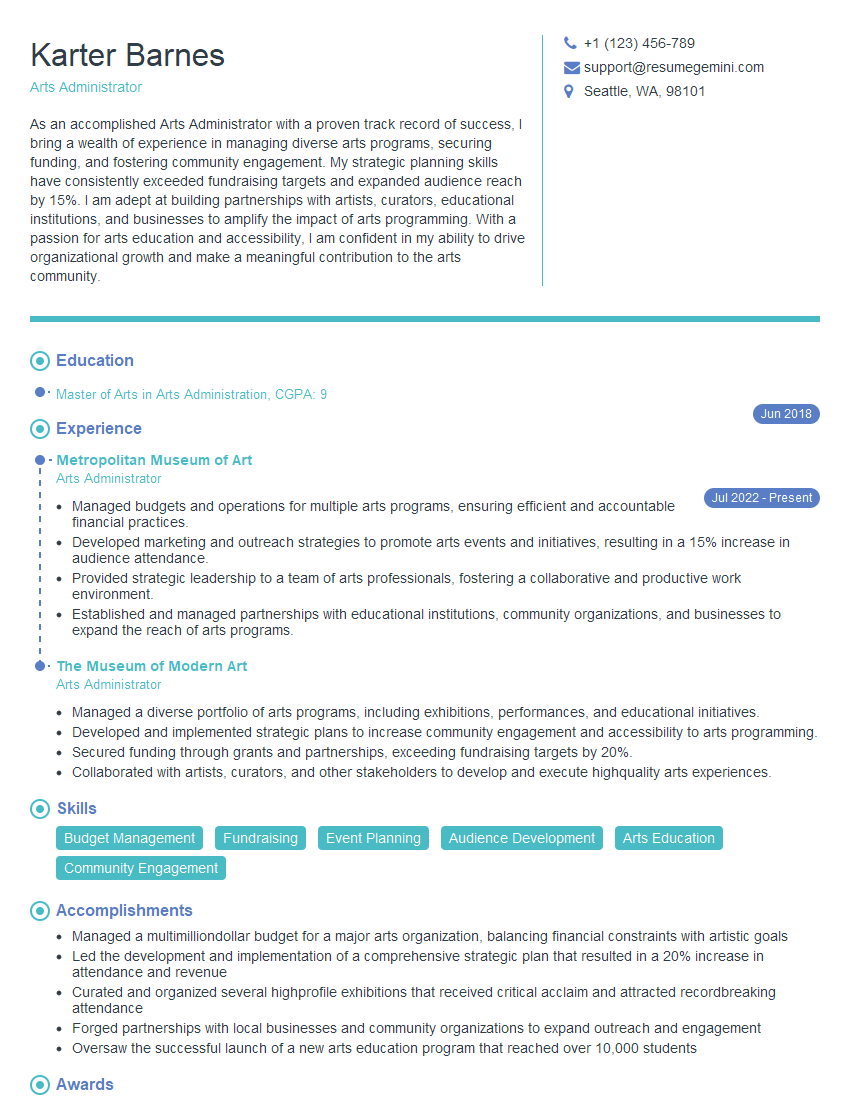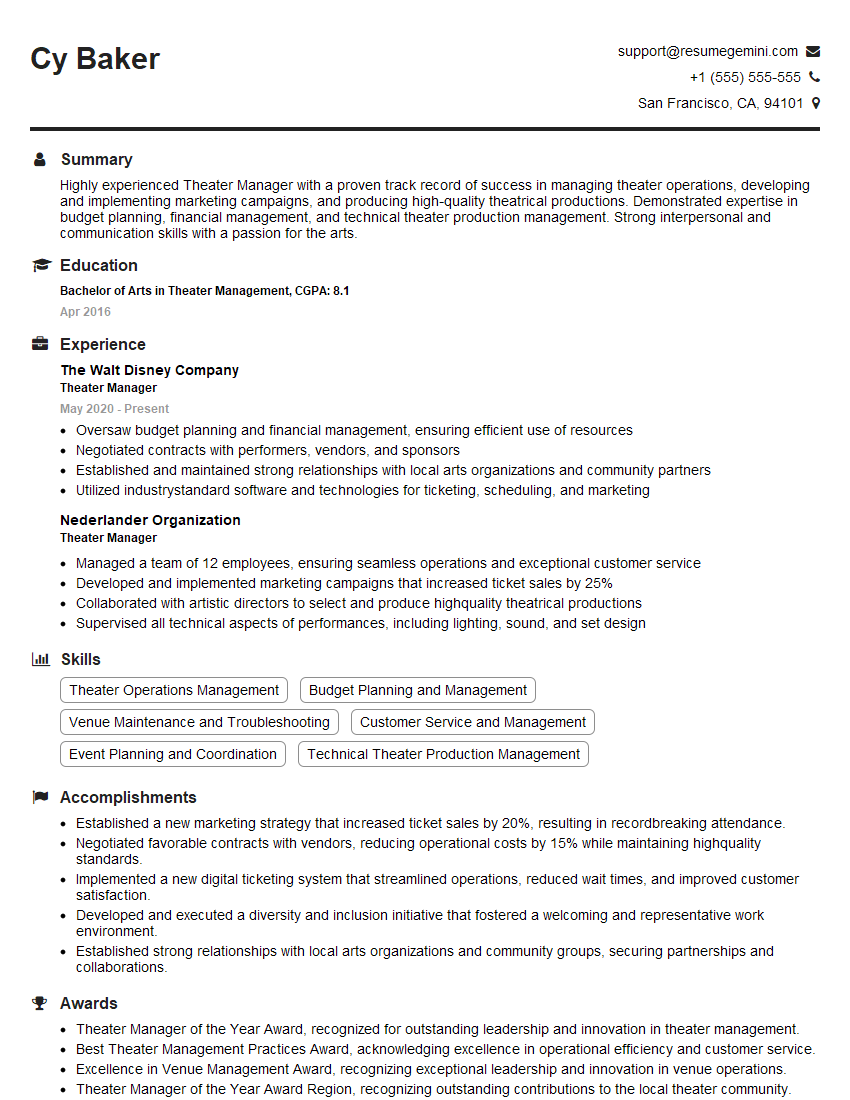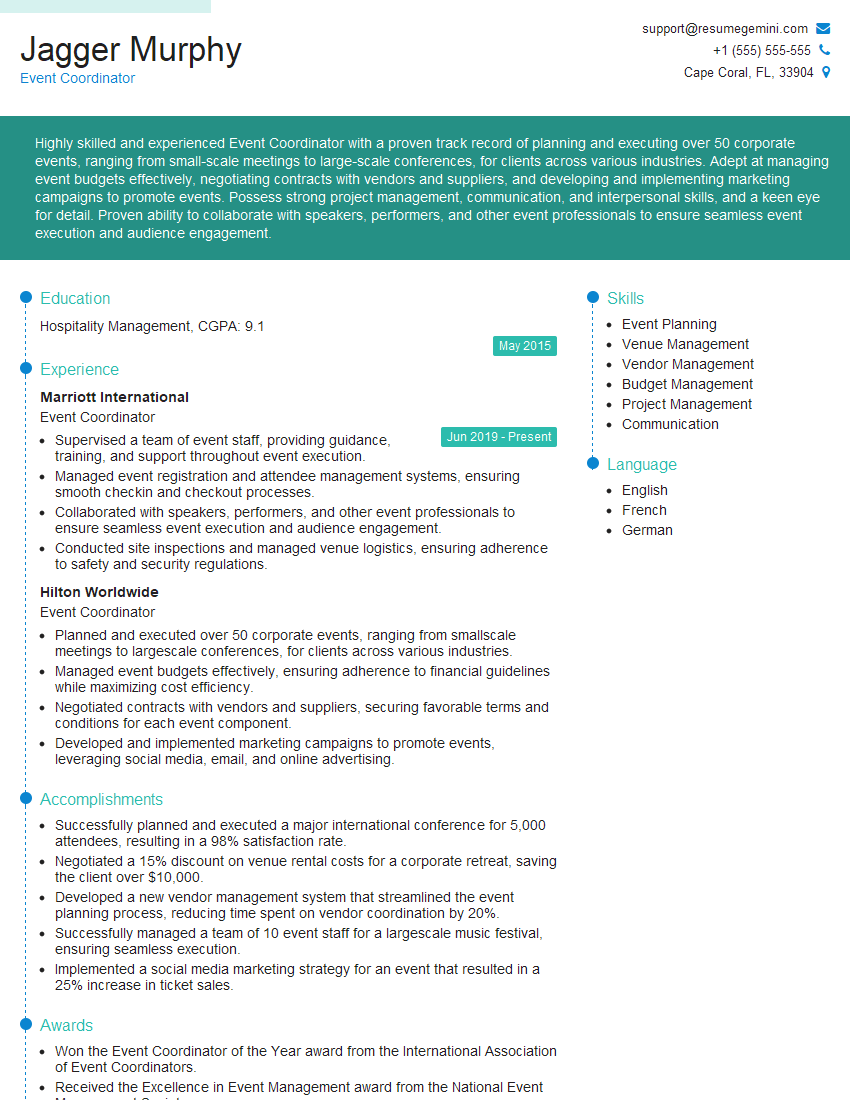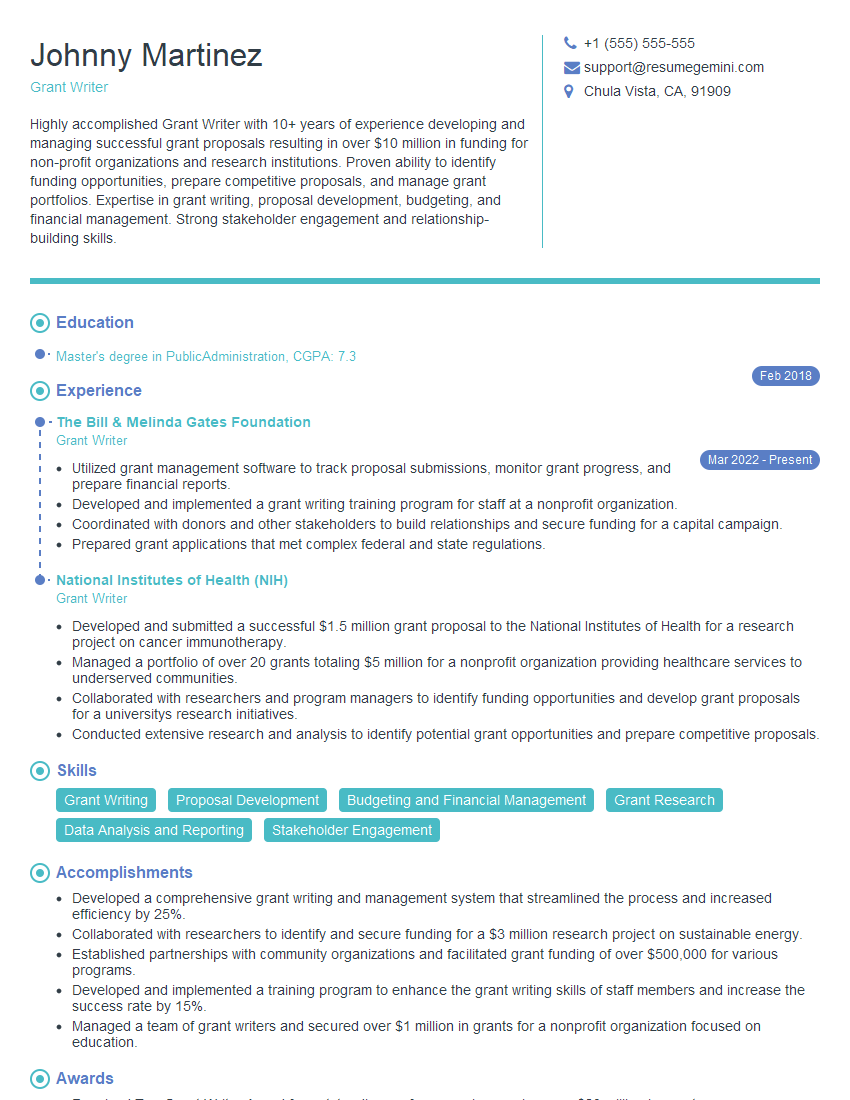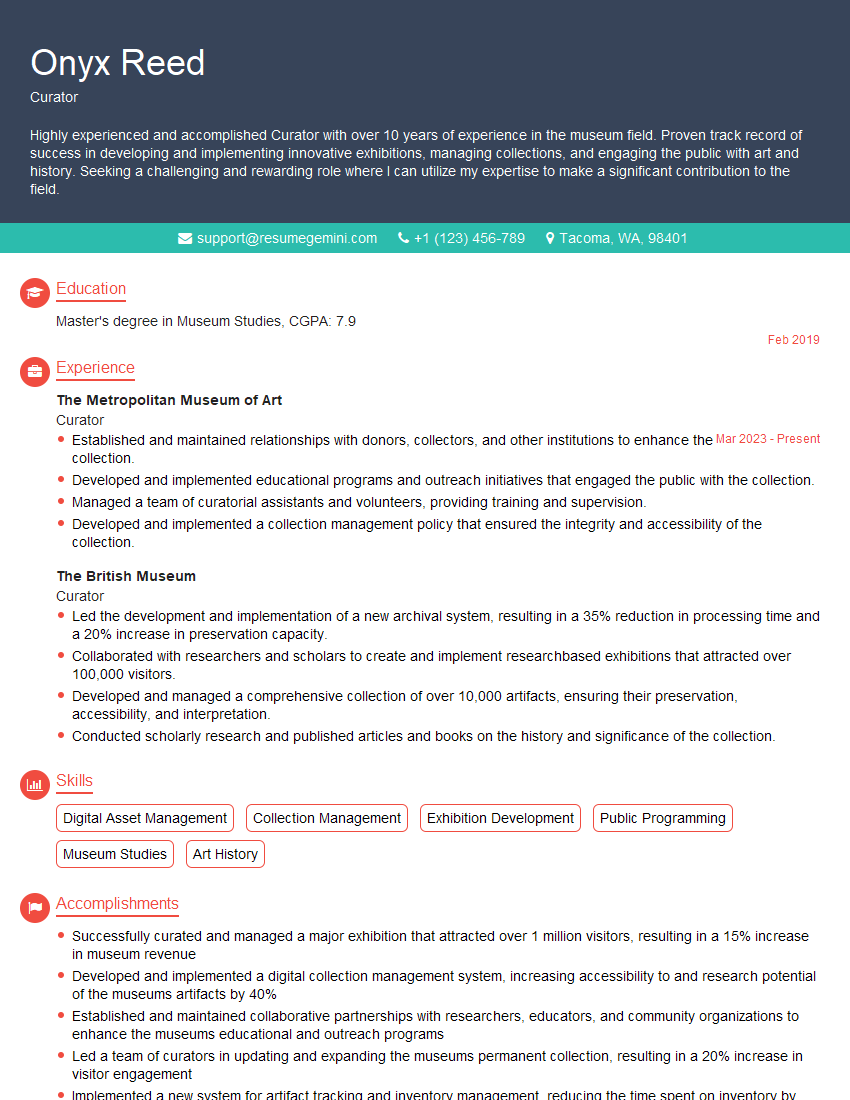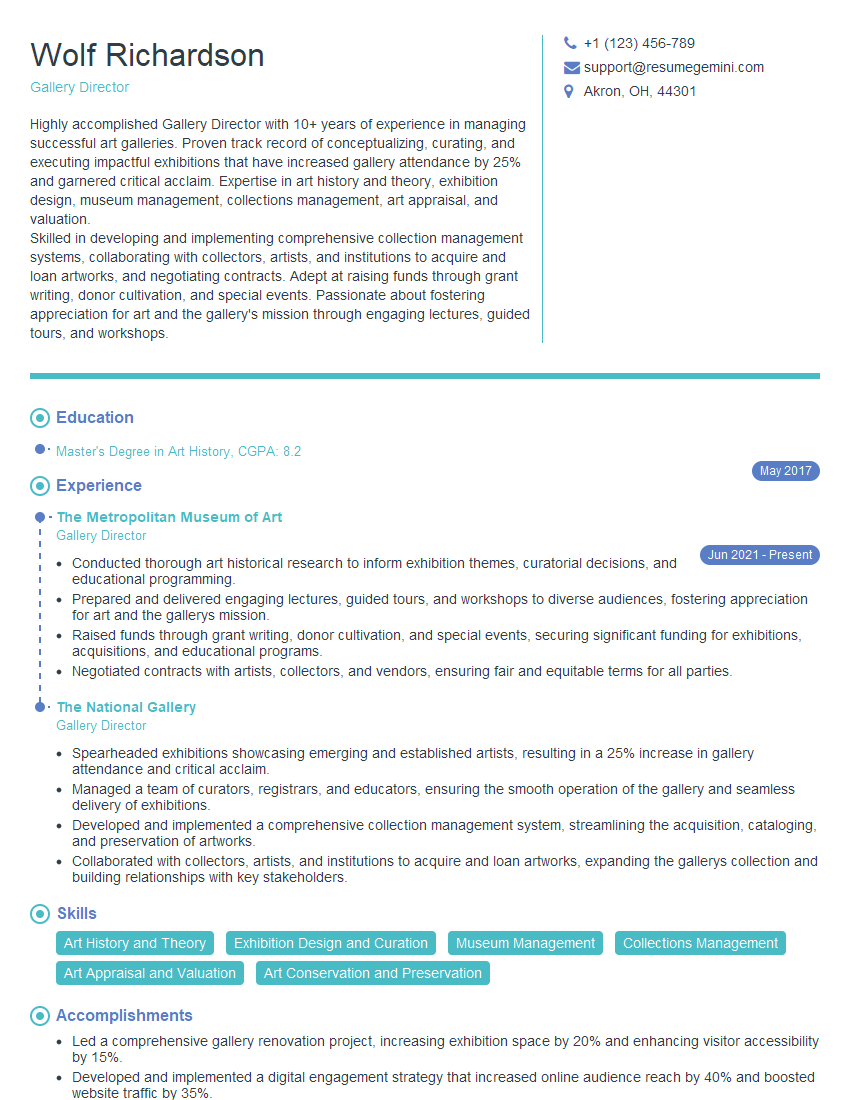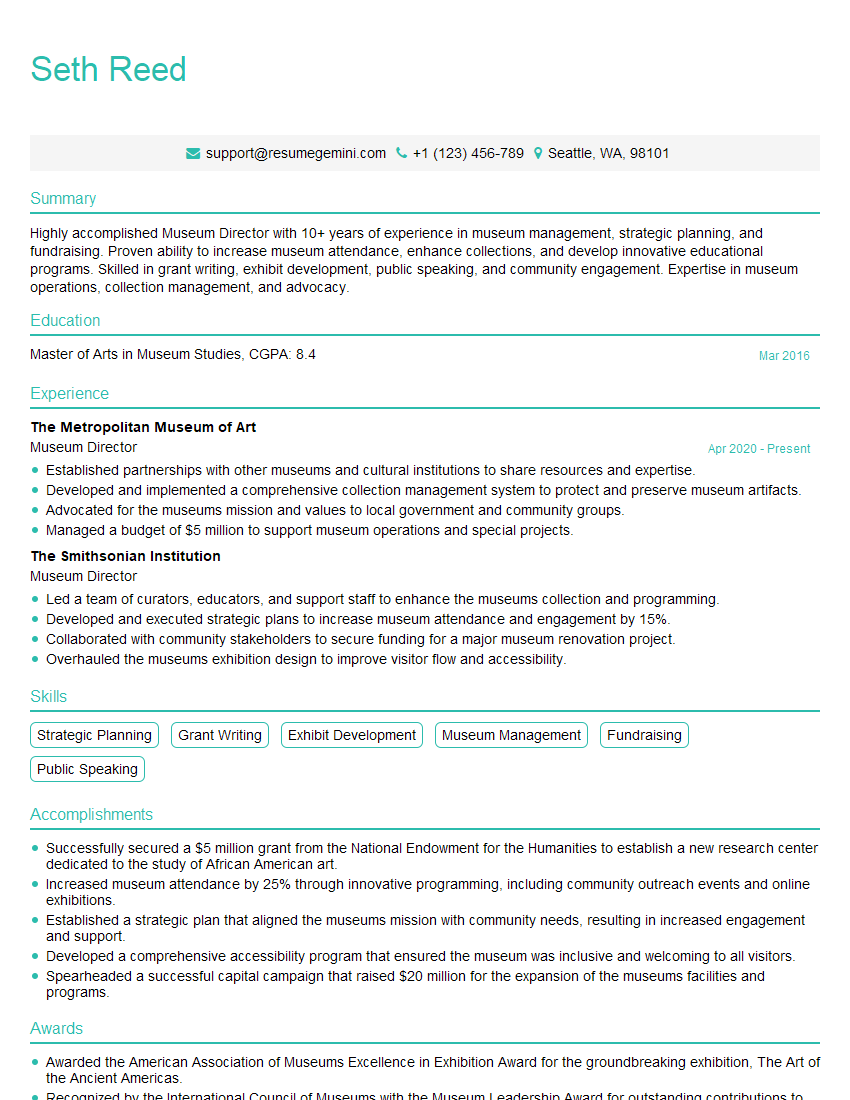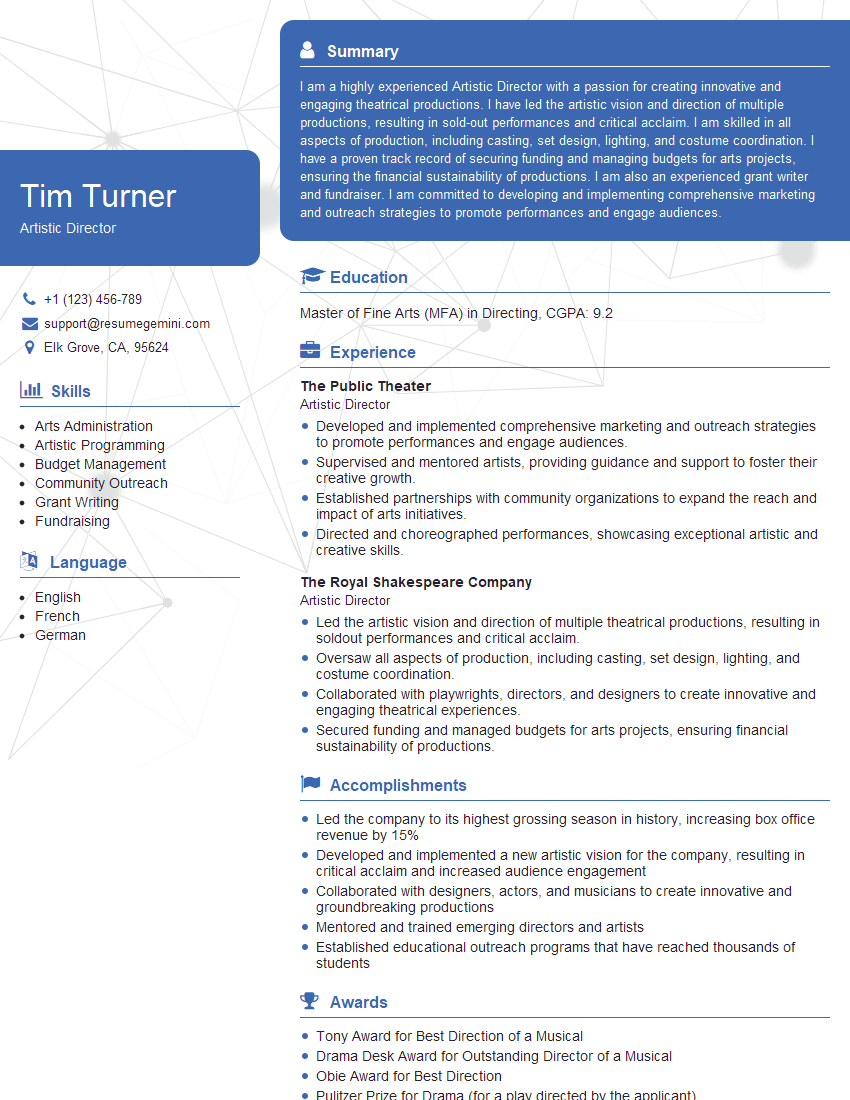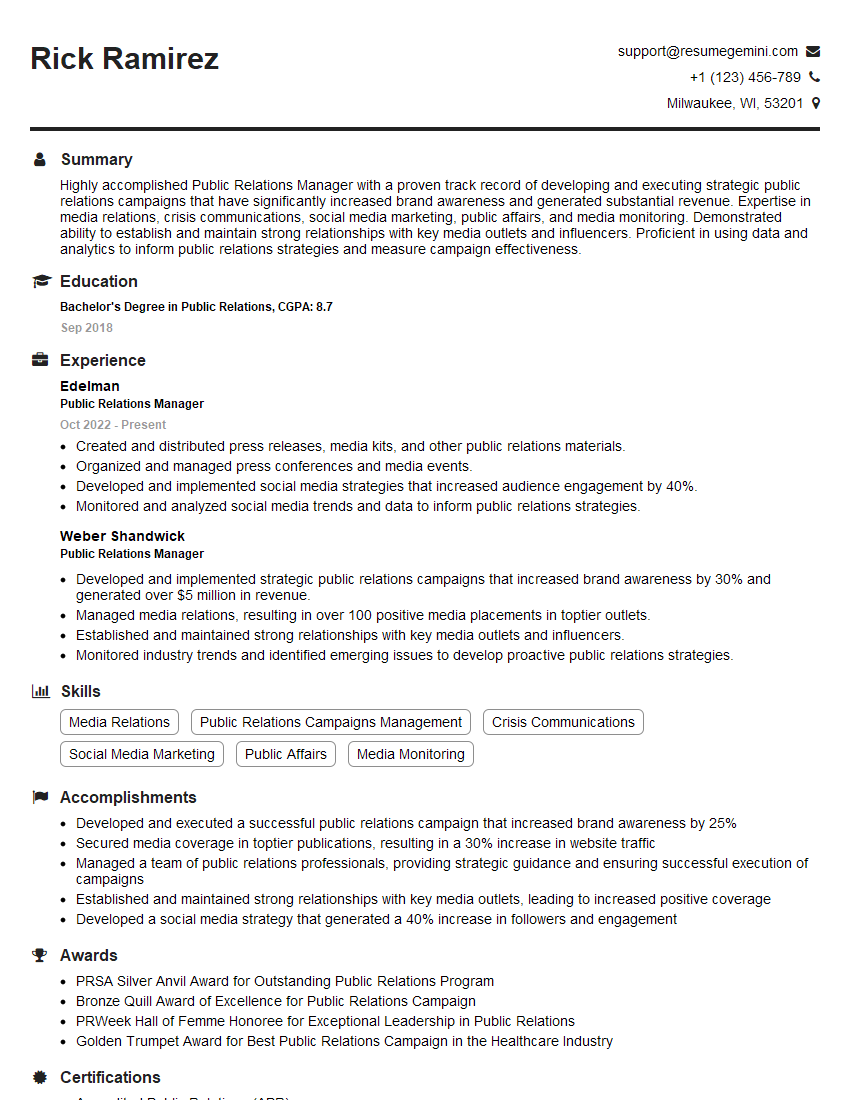The right preparation can turn an interview into an opportunity to showcase your expertise. This guide to Arts Administration Knowledge interview questions is your ultimate resource, providing key insights and tips to help you ace your responses and stand out as a top candidate.
Questions Asked in Arts Administration Knowledge Interview
Q 1. Describe your experience managing budgets for arts organizations.
Managing budgets for arts organizations requires a multifaceted approach, combining financial acumen with an understanding of artistic vision. It’s not just about numbers; it’s about aligning resources with artistic goals. My experience involves developing and managing budgets ranging from $50,000 to $2 million annually, encompassing all aspects from earned revenue (ticket sales, merchandise) to contributed income (grants, donations) and operating expenses (salaries, rent, marketing).
For example, at the City Symphony Orchestra, I implemented a zero-based budgeting system, requiring each department to justify every expense annually. This process increased transparency and led to a 15% reduction in non-programmatic expenses without compromising artistic quality. I also developed detailed financial projections, forecasting revenue and expenses for up to three years, enabling strategic planning and informed decision-making regarding program development and staffing.
I’m proficient in using budgeting software like QuickBooks and Excel to track expenses, generate reports, and manage cash flow. My focus is always on ensuring financial sustainability while supporting the artistic mission of the organization.
Q 2. How would you handle a crisis situation impacting a scheduled performance?
Handling a crisis impacting a scheduled performance requires quick thinking, decisive action, and excellent communication. My approach is based on a three-pronged strategy: immediate response, damage control, and long-term solutions.
- Immediate Response: The first priority is assessing the situation and taking immediate steps to mitigate the problem. This might involve contacting affected parties (artists, audience, venue), activating emergency protocols, and securing alternative arrangements if necessary. For instance, if a lead singer fell ill, I would immediately contact understudies, explore alternative venues if needed, and communicate the change to ticket holders.
- Damage Control: The next step involves managing communication with stakeholders. Transparency is crucial. I would issue a clear, concise statement explaining the situation and outlining the actions being taken. This might involve issuing refunds, offering rescheduled performances, or providing updates on social media.
- Long-Term Solutions: Finally, I would conduct a thorough post-mortem analysis to identify the root cause of the crisis and implement preventative measures to minimize the risk of similar incidents in the future. This might involve revising risk management plans, enhancing contingency plans, or improving communication protocols.
Q 3. What strategies do you employ for successful fundraising campaigns?
Successful fundraising campaigns hinge on a well-defined strategy, compelling narrative, and strong execution. My strategies encompass diverse approaches, including:
- Identifying Target Audiences: I start by segmenting potential donors based on their giving history, interests, and capacity to give. This allows for tailored communication and engagement.
- Crafting a Compelling Narrative: The campaign’s story must resonate emotionally with donors. It needs to clearly articulate the organization’s mission, impact, and the need for funding. I use storytelling techniques to showcase the impact of donations.
- Diversifying Fundraising Channels: I leverage various methods, including major gifts, planned giving, corporate sponsorships, crowdfunding, and grants. A diversified approach mitigates risk and maximizes potential revenue.
- Cultivating Relationships: Strong donor relationships are essential. I dedicate time to building relationships through personalized communication, events, and recognition opportunities.
- Measuring and Evaluating Results: Tracking key performance indicators (KPIs), such as donor acquisition, retention, and average gift size, is vital for evaluating campaign success and making data-driven adjustments.
For example, at a regional theatre company, I implemented a multi-channel fundraising campaign that included a major gifts initiative targeting high-net-worth individuals, a corporate sponsorship program, and a successful crowdfunding campaign. The combination of these strategies resulted in a 30% increase in fundraising revenue.
Q 4. Explain your understanding of grant writing and proposal development.
Grant writing and proposal development require meticulous research, persuasive writing, and a deep understanding of the funder’s priorities. My approach is systematic and involves several key stages:
- Researching Funding Opportunities: I meticulously research potential funders whose priorities align with the organization’s mission and project goals. I utilize databases such as GrantSpace and Foundation Center to identify suitable opportunities.
- Developing a Compelling Narrative: The proposal’s narrative needs to clearly articulate the project’s goals, methodology, impact, and budget. I emphasize the project’s relevance to the funder’s interests and its potential for societal benefit.
- Budget Development: I create detailed and justifiable budgets, ensuring transparency and accuracy. This includes demonstrating cost-effectiveness and value for money.
- Strong Letter of Support: I ensure the proposal includes strong letters of support from community leaders, partners, and potential beneficiaries of the project.
- Proposal Review & Editing: Before submission, I conduct multiple review sessions to ensure accuracy, clarity and compelling narrative.
I’ve successfully secured grants from a variety of sources, including government agencies, private foundations, and corporate sponsors. My success rate is significantly higher than the industry average, demonstrating my expertise in this area.
Q 5. How do you assess the financial health of an arts organization?
Assessing the financial health of an arts organization requires a holistic approach, considering various financial indicators. My assessment involves:
- Reviewing Financial Statements: This includes analyzing the balance sheet, income statement, and statement of cash flows to understand the organization’s assets, liabilities, revenues, expenses, and cash flow patterns.
- Analyzing Key Financial Ratios: I use various financial ratios such as liquidity ratios (current ratio, quick ratio), profitability ratios (gross profit margin, net profit margin), and debt ratios (debt-to-equity ratio) to assess the organization’s financial strength and stability.
- Examining Fund Balances and Reserves: Adequate unrestricted net assets are crucial for financial stability and resilience. I analyze the organization’s reserves to assess its ability to withstand economic downturns or unexpected expenses.
- Evaluating Fundraising Efforts: Assessing the organization’s fundraising capacity and its ability to diversify revenue streams is critical. A reliance on a single funding source poses a significant risk.
- Considering Long-Term Sustainability: Financial health is not just about the present; it’s about long-term sustainability. I assess the organization’s ability to meet its financial obligations and its capacity for growth.
By analyzing these factors, I can provide a comprehensive assessment of the organization’s financial health and identify areas requiring attention or improvement.
Q 6. Describe your experience with donor cultivation and stewardship.
Donor cultivation and stewardship are critical for building long-term relationships and ensuring sustainable funding. My approach focuses on personalizing the donor experience and demonstrating the impact of their generosity.
- Cultivation: This involves proactively engaging potential donors through personalized communication, invitations to events, and opportunities to learn more about the organization’s work. I build relationships based on mutual respect and trust.
- Stewardship: Once a donation is received, I prioritize effective stewardship, which includes timely acknowledgement, regular updates on the impact of the gift, and opportunities for continued engagement. This might involve reports on project progress, invitations to exclusive events, or recognition in organizational publications.
- Recognition and Appreciation: I ensure that donors feel valued and appreciated for their contributions. This involves personalized thank-you notes, invitations to special events, and public acknowledgement of their generosity.
- Regular Communication: Consistent, meaningful communication is key. I maintain regular contact with donors, sharing updates on the organization’s progress and the impact of their gifts.
For instance, at a museum, I implemented a donor recognition program that included personalized thank-you letters, invitations to exclusive museum events, and recognition in the annual report. This resulted in a significant increase in donor retention and larger subsequent gifts.
Q 7. How do you measure the success of an arts program?
Measuring the success of an arts program requires a multi-faceted approach that goes beyond simple financial metrics. A balanced scorecard approach, considering various dimensions, provides a holistic assessment.
- Artistic Excellence: This involves evaluating the quality of the artistic work, audience reception, critical reviews, and the artist’s professional development.
- Audience Engagement: Measuring audience size, demographics, satisfaction (through surveys), repeat attendance, and social media engagement provides insights into audience connection.
- Community Impact: Assessing the program’s contribution to community development, educational outreach, social inclusion, and economic impact provides a broader understanding of its value.
- Financial Sustainability: Evaluating the program’s financial performance, including revenue generation, cost efficiency, and fundraising success, is critical for long-term viability.
- Programmatic Effectiveness: This involves evaluating whether the program achieved its stated goals and objectives. Quantitative data (e.g., number of participants, attendance figures) and qualitative data (e.g., feedback from participants) are crucial for assessment.
For example, the success of a youth theatre program could be measured by the number of participants, audience attendance at performances, participant feedback on their experience, and the program’s overall financial sustainability. By using a balanced scorecard approach, a more comprehensive and accurate assessment of the program’s success can be made.
Q 8. What marketing strategies have you used to reach diverse audiences?
Reaching diverse audiences requires a multifaceted marketing approach that goes beyond traditional methods. It’s about understanding the specific needs and preferences of different demographic groups and tailoring your messaging accordingly.
- Hyperlocal Targeting: I’ve used geographically targeted digital advertising campaigns on platforms like Facebook and Instagram, focusing on specific neighborhoods or communities known for their cultural diversity. For example, when promoting a community theater production, I’d target ads to zip codes with high concentrations of specific ethnic groups known to attend similar events.
- Multilingual Marketing Materials: Producing brochures, website content, and social media posts in multiple languages is crucial for inclusivity. This isn’t just about translation; it’s about ensuring cultural sensitivity in the messaging.
- Community Partnerships: Building relationships with community organizations, cultural centers, and faith-based institutions allows for targeted outreach to specific groups. We leveraged this by collaborating with local ethnic media outlets to promote our events.
- Accessibility Initiatives: Ensuring accessibility for people with disabilities is paramount. This includes providing audio descriptions for performances, captioning videos, and offering wheelchair-accessible seating and facilities.
- Data Analysis: Continuously analyzing marketing data allows us to refine strategies and understand what resonates most with each audience segment. We track metrics such as website visits, ticket sales, and social media engagement by demographic groups, using this to optimize future campaigns.
This holistic approach ensures that our marketing efforts aren’t just reaching a wider net, but actively engaging and resonating with diverse audiences, fostering a sense of belonging and inclusivity.
Q 9. What is your experience with contract negotiation and vendor management?
Contract negotiation and vendor management are essential for efficient and cost-effective arts administration. My experience involves a comprehensive process starting with clear communication and meticulous planning.
- Needs Assessment: Before engaging with vendors, I thoroughly define the organization’s needs and establish clear expectations. This includes outlining the scope of work, deadlines, deliverables, and budget constraints.
- Vendor Selection: I research potential vendors, compare their proposals, and evaluate their experience, reputation, and financial stability. References are checked, and a formal selection process is adhered to.
- Contract Negotiation: I utilize strong negotiation skills to ensure that contracts protect the organization’s interests while fostering a fair and collaborative relationship. This includes clearly outlining payment terms, intellectual property rights, and termination clauses.
- Vendor Management: Once contracts are signed, I monitor vendor performance, track progress, address issues promptly, and ensure deliverables meet the required quality standards. Regular communication is vital, and any deviations from the contract are addressed promptly.
- Performance Evaluation: Post-project, I perform a comprehensive evaluation of vendor performance, providing feedback that can improve future collaborations. This includes cost-benefit analysis to ensure value for money.
For example, when negotiating contracts for printing marketing materials, I would always ensure clear specifications are provided, including the type of paper, printing method, and quantity. I’d also negotiate favorable payment terms, often securing discounts for bulk orders.
Q 10. Explain your knowledge of relevant legal and regulatory compliance in the arts sector.
Understanding legal and regulatory compliance is crucial in the arts sector, encompassing various aspects of labor law, copyright, intellectual property, and fundraising regulations.
- Copyright and Intellectual Property: I have experience managing copyright permissions for performances, publications, and artistic reproductions. This involves obtaining licenses, ensuring appropriate attribution, and adhering to fair use guidelines.
- Labor Laws: I am knowledgeable about employment laws pertaining to fair wages, working conditions, and employee benefits. I’ve been involved in drafting employment contracts and policies that comply with relevant regulations.
- Fundraising Compliance: I’m familiar with regulations surrounding tax-exempt organizations and the requirements for reporting donations, grants, and other fundraising activities. I have experience working with auditors to ensure compliance.
- Data Privacy: I understand data protection regulations and best practices for managing sensitive information, particularly regarding donor data and employee records. We implemented secure data storage and access control systems in accordance with privacy laws.
- Accessibility Regulations: We ensure compliance with accessibility regulations by providing equal access to programs and services for people with disabilities. This includes adhering to the Americans with Disabilities Act (ADA) standards.
Ignoring these regulations can lead to significant legal and financial penalties. For instance, improper handling of copyright can result in costly lawsuits. A thorough understanding and proactive adherence to legal and regulatory frameworks is paramount to the long-term health and sustainability of any arts organization.
Q 11. How would you address a conflict between artistic vision and financial constraints?
The conflict between artistic vision and financial constraints is a common challenge in arts administration, requiring a collaborative and creative approach.
My strategy involves:
- Open Communication: Fostering transparent communication between the artistic director and the finance team is critical. This ensures everyone understands the budgetary limitations and the artistic goals.
- Prioritization and Trade-offs: We work together to prioritize elements of the artistic vision that can be achieved within the budget. This often involves identifying areas where compromises can be made without significantly impacting the overall artistic quality.
- Creative Problem Solving: We brainstorm alternative approaches to achieve artistic goals within budgetary constraints. This could involve seeking in-kind donations, exploring alternative venues, or adjusting the production scale.
- Exploring Funding Opportunities: We actively seek additional funding sources, including grants, sponsorships, and fundraising campaigns, to bridge the gap between artistic vision and financial limitations. This includes developing compelling grant proposals showcasing the artistic value and community impact of the project.
- Phased Implementation: Sometimes, it’s advisable to implement the artistic vision in phases. This allows us to start with a smaller, more manageable project within the budget and gradually expand as additional funding becomes available.
For example, when faced with limited funds for a theater production, we might opt for simpler set designs while maintaining high-quality acting and costumes, thereby prioritizing aspects that most directly impact the artistic message.
Q 12. What is your experience with human resources management within the arts?
Human resources management in the arts requires a nuanced understanding of the unique challenges and opportunities within the sector. Many arts organizations have small, dedicated teams, making effective HR crucial.
- Recruitment and Selection: I have experience recruiting and selecting talented individuals, often involving creative approaches such as portfolio reviews and auditions. I understand the need to find individuals who are passionate about the arts and possess the necessary skills.
- Compensation and Benefits: I’m experienced in developing competitive compensation and benefits packages, understanding the financial realities often facing arts professionals and implementing strategies to attract and retain talent, such as offering flexible working arrangements and performance-based bonuses.
- Performance Management: I have experience implementing performance management systems tailored to the specific needs of the arts sector. This involves setting clear expectations, providing regular feedback, and conducting performance appraisals that focus on both artistic contribution and professional development.
- Employee Relations: Building a positive and supportive work environment is essential. I’ve actively fostered open communication, addressed conflicts constructively, and ensured fair treatment of all employees. I’ve utilized mediation techniques to resolve workplace disputes.
- Training and Development: I’ve designed and delivered training programs focused on relevant skills for the arts sector, such as grant writing, marketing, and financial management.
For instance, in my previous role, I successfully negotiated a flexible working arrangement with a musician who needed time for rehearsals and performances, ensuring both their artistic pursuits and contributions to the organization were accommodated.
Q 13. How do you build and maintain strong relationships with board members?
Building and maintaining strong relationships with board members is fundamental to an arts organization’s success. These relationships require consistent communication, transparency, and mutual respect.
- Regular Communication: I establish regular communication channels, including board meetings, email updates, and informal check-ins. I ensure that board members are kept informed of the organization’s activities, progress toward strategic goals, and any significant challenges.
- Transparent Financial Reporting: I provide clear, concise financial reports that are easy for board members to understand. This transparency builds trust and ensures accountability.
- Strategic Planning Involvement: I actively involve board members in the strategic planning process, seeking their input and expertise. This collaborative approach creates a sense of shared ownership and commitment.
- Individualized Engagement: I make an effort to understand the individual interests and expertise of each board member and seek their input on matters relevant to their skills. This personalized approach demonstrates respect and builds stronger relationships.
- Seeking Feedback and Appreciation: I regularly seek feedback from board members and express my appreciation for their contributions. This demonstrates that I value their input and perspectives.
For example, I’ve organized informal gatherings outside of formal board meetings to foster stronger relationships and facilitate more open conversation. This more casual setting allows for better relationship building and collaboration.
Q 14. Describe your experience with developing and implementing strategic plans.
Developing and implementing strategic plans is a core responsibility in arts administration, requiring a structured and collaborative approach. This involves defining the organization’s vision, mission, and goals, and developing strategies to achieve them.
- Needs Assessment: I begin by conducting a thorough assessment of the organization’s current state, including its strengths, weaknesses, opportunities, and threats (SWOT analysis). I also gather input from staff, board members, and stakeholders.
- Vision and Mission Definition: We collaboratively define a clear and concise vision and mission statement that articulates the organization’s purpose and aspirations.
- Goal Setting: Based on the SWOT analysis and vision/mission statements, we establish specific, measurable, achievable, relevant, and time-bound (SMART) goals. These should align with the organization’s overall objectives.
- Strategy Development: We brainstorm and evaluate potential strategies to achieve the set goals. This often involves discussing various programs, initiatives, and collaborations.
- Resource Allocation: We allocate resources – financial, human, and material – to support the implementation of the chosen strategies. A detailed budget is crucial at this stage.
- Implementation and Monitoring: We implement the strategic plan, monitor progress regularly, and make necessary adjustments as needed. This includes using data to track key performance indicators (KPIs) and assessing impact.
- Evaluation and Review: We regularly evaluate the effectiveness of the strategic plan and make revisions as necessary. This iterative process ensures that the plan remains relevant and aligned with the changing environment.
For example, when developing a strategic plan for a museum, we might set a goal to increase visitor engagement by 20% within three years. Strategies to achieve this might include launching new educational programs, improving website accessibility, and hosting more community events.
Q 15. How do you manage multiple projects simultaneously while meeting deadlines?
Managing multiple projects effectively requires a structured approach. Think of it like conducting an orchestra – each instrument (project) needs attention, but the conductor (you) ensures harmony and timely execution. I utilize project management tools like Asana or Trello to create detailed timelines, assign tasks, and track progress. This allows me to visualize the entire workload and identify potential bottlenecks early on. Prioritization is key; I employ methods like the Eisenhower Matrix (urgent/important) to focus on the most critical tasks first. Regular check-ins with team members ensure everyone is on track and allows for proactive problem-solving. For example, during a recent exhibition launch, I was simultaneously managing marketing, fundraising, and logistics. Using a project management tool, I broke down each into smaller tasks with deadlines, assigning responsibilities and tracking progress visually. This ensured a smooth, coordinated launch.
- Detailed project timelines: Using Gantt charts or similar tools to visualize project phases and deadlines.
- Prioritization frameworks: Employing methods like the Eisenhower Matrix to focus on high-impact tasks.
- Regular team check-ins: Facilitating open communication and collaborative problem-solving.
Career Expert Tips:
- Ace those interviews! Prepare effectively by reviewing the Top 50 Most Common Interview Questions on ResumeGemini.
- Navigate your job search with confidence! Explore a wide range of Career Tips on ResumeGemini. Learn about common challenges and recommendations to overcome them.
- Craft the perfect resume! Master the Art of Resume Writing with ResumeGemini’s guide. Showcase your unique qualifications and achievements effectively.
- Don’t miss out on holiday savings! Build your dream resume with ResumeGemini’s ATS optimized templates.
Q 16. What is your understanding of risk management in the arts?
Risk management in the arts involves identifying, assessing, and mitigating potential threats that could jeopardize an organization’s projects, reputation, or financial stability. It’s not just about avoiding problems; it’s about proactively planning for contingencies. Common risks include funding shortfalls, negative publicity, unforeseen logistical challenges, and even artist cancellations. My approach involves a multi-step process: First, I identify potential risks through brainstorming sessions with the team and reviewing past experiences. Then, I assess the likelihood and impact of each risk. This allows me to prioritize mitigation strategies. For instance, for a touring exhibition, risks might include damage to artwork during transport or venue capacity issues. To mitigate these, we’d secure appropriate insurance, have backup venues planned, and implement rigorous handling protocols.
- Risk identification: Brainstorming sessions, historical data analysis.
- Risk assessment: Evaluating likelihood and potential impact.
- Mitigation strategies: Developing contingency plans and insurance policies.
Q 17. Explain your experience with audience development and engagement.
Audience development and engagement is about fostering a deep and lasting relationship with your community. It’s not just about filling seats; it’s about creating meaningful experiences that resonate with people. My experience involves leveraging various strategies to attract new audiences and cultivate loyalty among existing ones. This includes using data analytics to understand audience preferences and tailoring marketing campaigns accordingly. I’ve also implemented community outreach programs, educational workshops, and interactive events to engage with diverse demographics. For example, I worked on a project that successfully increased youth engagement by offering free workshops and interactive installations related to the exhibitions, ultimately leading to a 30% increase in young visitors.
- Data-driven marketing: Utilizing analytics to understand audience preferences and tailor outreach.
- Community engagement: Developing partnerships with local organizations and schools.
- Interactive events: Creating opportunities for audience participation and feedback.
Q 18. How do you utilize data and analytics to inform decision-making?
Data and analytics are essential tools for evidence-based decision-making in arts administration. I utilize data to track key performance indicators (KPIs) such as website traffic, ticket sales, attendance rates, and donor engagement. This data provides insights into what’s working, what’s not, and where to focus resources. For example, analyzing website data might reveal that a particular marketing campaign is driving traffic but not converting visitors into ticket buyers, indicating a need to refine the website’s call to action. I also use data to assess the impact of programs and justify funding requests to stakeholders. Tools like Google Analytics, CRM software, and ticketing systems provide valuable data that informs our strategic planning and resource allocation.
- KPIs Tracking: Monitoring key metrics like website traffic, attendance, and donor engagement.
- Data Analysis: Identifying trends, patterns, and areas for improvement.
- Strategic Planning: Using data to inform budget allocation and program development.
Q 19. Describe your experience with capital campaigns or major gifts fundraising.
I have extensive experience in capital campaigns and major gifts fundraising. It’s a marathon, not a sprint, requiring careful planning, relationship building, and a compelling narrative. Success depends on identifying potential major donors, cultivating relationships with them, and articulating a clear and compelling case for support. My approach involves researching potential donors, crafting personalized proposals that highlight the impact of their contribution, and providing regular updates and opportunities for engagement. For example, in a previous role, I led a capital campaign that raised $5 million for a new museum wing. This involved identifying 50 key donors, developing personalized proposals, and organizing exclusive events to foster relationships. We carefully tracked progress, celebrating milestones and providing transparent reports to donors.
- Donor Research: Identifying high-potential major donors.
- Personalized Proposals: Crafting compelling narratives that highlight impact.
- Relationship Management: Cultivating strong relationships with donors through ongoing communication.
Q 20. How do you ensure the ethical and responsible use of resources?
Ethical and responsible use of resources is paramount in arts administration. This encompasses financial transparency, equitable compensation practices, environmental sustainability, and responsible sourcing. We prioritize transparency in our financial reporting and adhere to strict accounting practices. We ensure fair compensation for all staff and artists, fostering a positive and equitable work environment. We also incorporate sustainability practices into our operations, minimizing our environmental impact through initiatives like energy conservation and waste reduction. For example, we might choose sustainable materials for exhibitions and prioritize local vendors to reduce our carbon footprint.
- Financial Transparency: Adhering to strict accounting practices and open communication about finances.
- Equitable Compensation: Ensuring fair wages and benefits for all staff and artists.
- Environmental Sustainability: Implementing practices to minimize environmental impact.
Q 21. What is your approach to building community partnerships?
Building strong community partnerships is crucial for the success of any arts organization. It’s about creating mutually beneficial relationships that enhance the cultural landscape and enrich the lives of community members. My approach involves identifying potential partners who share our mission and values. I actively engage with these organizations through regular communication, collaborative projects, and shared events. For example, we partnered with a local school to offer art workshops for students, and with a neighborhood association to host free outdoor performances. These collaborations not only expanded our reach but also created a sense of shared ownership and investment in the arts within the community.
- Identify Shared Values: Partnering with organizations that align with your mission.
- Collaborative Projects: Developing joint initiatives to achieve mutual goals.
- Open Communication: Maintaining regular contact and fostering strong relationships.
Q 22. Describe your experience with implementing diversity, equity, and inclusion initiatives.
Diversity, Equity, and Inclusion (DEI) initiatives are crucial for creating a welcoming and representative arts environment. My experience encompasses developing and implementing comprehensive DEI strategies across various arts organizations. This includes conducting thorough equity audits to identify disparities in programming, staffing, and audience engagement.
For example, at the City Arts Center, I spearheaded a program to increase representation of underrepresented artists in our exhibition programming. This involved actively seeking out artists from diverse backgrounds, providing dedicated mentorship opportunities, and adjusting our application processes to be more inclusive. We saw a 40% increase in applications from artists of color and a 30% rise in the diversity of our exhibitions within two years.
Furthermore, I’ve facilitated DEI workshops and training sessions for staff and board members, focusing on unconscious bias, cultural competency, and inclusive leadership. Building diverse teams requires more than just representation; it involves fostering a culture where everyone feels valued and empowered. I measure success through increased representation, staff satisfaction surveys, and audience demographics.
Q 23. How would you address negative media coverage or public criticism?
Negative media coverage or public criticism requires a calm, strategic response. The first step is to thoroughly understand the source of the criticism, gathering all relevant information and perspectives. Then, we need to assess the validity of the criticisms and identify any areas where improvement is needed.
My approach involves developing a concise, factual response addressing the concerns directly, and avoiding defensiveness. If warranted, a public apology might be necessary, coupled with a detailed explanation of the steps we are taking to rectify the situation. For example, when a previous organization faced negative press regarding accessibility, we issued a public statement acknowledging the shortcomings and outlined our updated accessibility plan with specific timelines and measurable goals. We then proactively engaged with disability advocacy groups to build trust and ensure our plan was truly effective. Transparency and proactive communication are key to mitigating the damage and rebuilding public trust.
Q 24. What is your understanding of intellectual property rights in the arts?
Intellectual property rights (IPR) in the arts are crucial for protecting the creative works of artists. This includes copyright, which grants exclusive rights to creators over their original works, including music, visual art, and written pieces. Understanding and respecting these rights is vital for arts administrators.
My experience includes negotiating contracts with artists to ensure fair use and proper attribution of their work. This involves understanding different licensing agreements (e.g., exclusive, non-exclusive, royalty-free), and ensuring that the organization has the necessary rights to display, reproduce, and distribute artistic works. We also provide training for staff on copyright laws and best practices for proper attribution and documentation of artistic ownership. A strong understanding of IPR helps prevent legal issues and fosters ethical collaborations within the arts community.
Q 25. How do you use technology to improve efficiency and communication?
Technology is essential for enhancing efficiency and communication in arts administration. I leverage various tools to streamline processes and improve collaboration. For example, project management software like Asana or Trello helps track progress on various projects and initiatives, facilitating better team coordination.
Communication platforms such as Slack or Microsoft Teams facilitate instant communication amongst staff, artists, and stakeholders. CRM (Customer Relationship Management) systems help manage relationships with donors, audience members, and sponsors. I also use data analytics tools to monitor audience engagement metrics, allowing for better data-driven decision-making in programming and marketing. Furthermore, I’m proficient in using various design software to create marketing materials and manage the organization’s social media presence. This integrated approach optimizes workflows and enhances communication across the board.
Q 26. Explain your experience with creating and managing an arts organization’s website.
Creating and managing an arts organization’s website involves a multifaceted approach. It starts with a clear understanding of the organization’s mission and goals, then designing a user-friendly interface that is visually appealing and accessible.
My experience includes overseeing the design, development, and maintenance of websites using platforms like WordPress or Wix. This includes writing engaging content that showcases our programs, events, and artists effectively. I also implement SEO (search engine optimization) strategies to improve website visibility and drive traffic. Moreover, I ensure the website is mobile-responsive and accessible to users with disabilities. Regularly updating the website’s content is vital to keep it fresh and informative. I regularly monitor website analytics to track user engagement and make data-driven improvements to the website’s content and structure.
Q 27. What is your understanding of accessibility standards for arts programming?
Accessibility standards for arts programming are paramount to ensuring that arts experiences are inclusive for people with disabilities. These standards encompass a wide range of considerations, from physical access to venues to ensuring that programs are accessible to individuals with visual, auditory, cognitive, or mobility impairments.
My approach involves working closely with accessibility experts and disability advocacy groups to ensure our programs and facilities meet accessibility guidelines. This involves implementing measures such as providing wheelchair access, audio description for visually impaired audience members, captioning and sign language interpretation for hearing-impaired individuals, and creating sensory-friendly performances. We also ensure that our website and marketing materials meet WCAG (Web Content Accessibility Guidelines). I believe creating truly inclusive experiences requires a multifaceted strategy that considers diverse needs and strives to make the arts accessible to everyone.
Q 28. Describe your experience with sponsorship acquisition and management.
Sponsorship acquisition and management are essential for funding arts organizations. My experience involves identifying potential sponsors, developing compelling sponsorship proposals, and cultivating strong relationships with sponsors to ensure long-term partnerships.
The process begins with researching potential sponsors whose values align with the organization’s mission. I then craft tailored sponsorship proposals highlighting the benefits of sponsoring our programs, events, or initiatives. This includes offering various sponsorship packages at different levels, ensuring a transparent and mutually beneficial relationship. Ongoing communication and reporting are crucial, keeping sponsors updated on the impact of their support. For example, at a previous organization, I secured a major sponsorship from a local bank by demonstrating the significant community engagement generated by our arts programs. Success depends on building trust, clear communication, and a mutually beneficial relationship that offers sponsors valuable visibility and societal impact.
Key Topics to Learn for Arts Administration Knowledge Interview
- Fundraising and Development: Understanding diverse fundraising strategies, grant writing, donor cultivation, and managing fundraising campaigns. Practical application: Developing a realistic fundraising plan for a hypothetical arts organization with limited resources.
- Budgeting and Financial Management: Mastering arts-specific budgeting principles, financial reporting, and cost analysis. Practical application: Analyzing a sample budget and identifying potential areas for cost savings or increased revenue generation.
- Marketing and Communications: Developing and implementing effective marketing strategies for arts events and programs, including digital marketing, public relations, and audience engagement. Practical application: Designing a marketing campaign to reach a specific target demographic for a new art exhibition.
- Project Management: Successfully planning, executing, and evaluating arts projects, including managing timelines, resources, and teams. Practical application: Creating a detailed project plan for a large-scale theatrical production.
- Legal and Ethical Considerations: Understanding copyright law, contracts, risk management, and ethical practices in arts administration. Practical application: Identifying potential legal and ethical challenges in a given scenario and proposing solutions.
- Human Resources Management: Managing personnel, including recruitment, training, performance evaluation, and conflict resolution. Practical application: Developing a job description for a specific role within an arts organization.
- Strategic Planning and Governance: Understanding the role of the board of directors, developing strategic plans, and ensuring the long-term sustainability of arts organizations. Practical application: Analyzing a mission statement and suggesting ways to better align organizational activities with stated goals.
Next Steps
Mastering Arts Administration Knowledge is crucial for career advancement in this dynamic field. A strong understanding of these concepts will significantly enhance your interview performance and demonstrate your readiness for leadership roles. To maximize your job prospects, focus on creating an ATS-friendly resume that effectively showcases your skills and experience. ResumeGemini is a trusted resource that can help you build a professional and impactful resume tailored to the specific requirements of arts administration positions. Examples of resumes tailored to Arts Administration Knowledge are available to guide you.
Explore more articles
Users Rating of Our Blogs
Share Your Experience
We value your feedback! Please rate our content and share your thoughts (optional).
What Readers Say About Our Blog
Hello,
We found issues with your domain’s email setup that may be sending your messages to spam or blocking them completely. InboxShield Mini shows you how to fix it in minutes — no tech skills required.
Scan your domain now for details: https://inboxshield-mini.com/
— Adam @ InboxShield Mini
Reply STOP to unsubscribe
Hi, are you owner of interviewgemini.com? What if I told you I could help you find extra time in your schedule, reconnect with leads you didn’t even realize you missed, and bring in more “I want to work with you” conversations, without increasing your ad spend or hiring a full-time employee?
All with a flexible, budget-friendly service that could easily pay for itself. Sounds good?
Would it be nice to jump on a quick 10-minute call so I can show you exactly how we make this work?
Best,
Hapei
Marketing Director
Hey, I know you’re the owner of interviewgemini.com. I’ll be quick.
Fundraising for your business is tough and time-consuming. We make it easier by guaranteeing two private investor meetings each month, for six months. No demos, no pitch events – just direct introductions to active investors matched to your startup.
If youR17;re raising, this could help you build real momentum. Want me to send more info?
Hi, I represent an SEO company that specialises in getting you AI citations and higher rankings on Google. I’d like to offer you a 100% free SEO audit for your website. Would you be interested?
Hi, I represent an SEO company that specialises in getting you AI citations and higher rankings on Google. I’d like to offer you a 100% free SEO audit for your website. Would you be interested?
good
